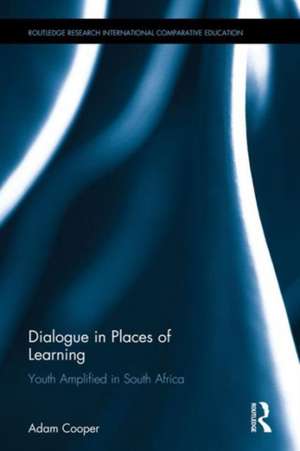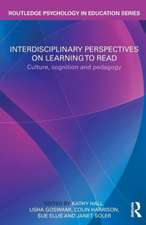Dialogue in Places of Learning: Youth Amplified in South Africa: Routledge Research in International and Comparative Education
Autor Adam Cooperen Limba Engleză Hardback – 7 iul 2016
Din seria Routledge Research in International and Comparative Education
-
 Preț: 316.63 lei
Preț: 316.63 lei -
 Preț: 310.85 lei
Preț: 310.85 lei -
 Preț: 310.03 lei
Preț: 310.03 lei - 9%
 Preț: 934.66 lei
Preț: 934.66 lei -
 Preț: 311.37 lei
Preț: 311.37 lei -
 Preț: 665.74 lei
Preț: 665.74 lei -
 Preț: 302.40 lei
Preț: 302.40 lei -
 Preț: 302.37 lei
Preț: 302.37 lei -
 Preț: 305.45 lei
Preț: 305.45 lei -
 Preț: 318.07 lei
Preț: 318.07 lei -
 Preț: 303.42 lei
Preț: 303.42 lei - 18%
 Preț: 1216.52 lei
Preț: 1216.52 lei -
 Preț: 402.66 lei
Preț: 402.66 lei - 18%
 Preț: 994.74 lei
Preț: 994.74 lei - 18%
 Preț: 1169.45 lei
Preț: 1169.45 lei -
 Preț: 388.64 lei
Preț: 388.64 lei - 18%
 Preț: 1000.27 lei
Preț: 1000.27 lei - 12%
 Preț: 318.90 lei
Preț: 318.90 lei - 18%
 Preț: 1054.71 lei
Preț: 1054.71 lei - 18%
 Preț: 1001.84 lei
Preț: 1001.84 lei - 18%
 Preț: 1000.27 lei
Preț: 1000.27 lei - 18%
 Preț: 1056.35 lei
Preț: 1056.35 lei - 28%
 Preț: 876.38 lei
Preț: 876.38 lei - 31%
 Preț: 765.43 lei
Preț: 765.43 lei -
 Preț: 482.35 lei
Preț: 482.35 lei - 18%
 Preț: 1057.09 lei
Preț: 1057.09 lei - 26%
 Preț: 848.96 lei
Preț: 848.96 lei -
 Preț: 402.66 lei
Preț: 402.66 lei - 18%
 Preț: 1166.68 lei
Preț: 1166.68 lei - 18%
 Preț: 1060.87 lei
Preț: 1060.87 lei - 31%
 Preț: 764.20 lei
Preț: 764.20 lei - 31%
 Preț: 766.12 lei
Preț: 766.12 lei - 18%
 Preț: 1052.35 lei
Preț: 1052.35 lei - 18%
 Preț: 259.98 lei
Preț: 259.98 lei - 28%
 Preț: 848.23 lei
Preț: 848.23 lei - 26%
 Preț: 763.78 lei
Preț: 763.78 lei - 16%
 Preț: 305.97 lei
Preț: 305.97 lei - 18%
 Preț: 1000.27 lei
Preț: 1000.27 lei - 12%
 Preț: 318.90 lei
Preț: 318.90 lei - 18%
 Preț: 1051.60 lei
Preț: 1051.60 lei - 18%
 Preț: 1167.61 lei
Preț: 1167.61 lei
Preț: 818.28 lei
Preț vechi: 1139.53 lei
-28% Nou
Puncte Express: 1227
Preț estimativ în valută:
156.57€ • 163.49$ • 129.30£
156.57€ • 163.49$ • 129.30£
Carte tipărită la comandă
Livrare economică 15-29 aprilie
Preluare comenzi: 021 569.72.76
Specificații
ISBN-13: 9781138194632
ISBN-10: 1138194638
Pagini: 190
Ilustrații: 6
Dimensiuni: 152 x 229 x 15 mm
Greutate: 0.36 kg
Ediția:1
Editura: Taylor & Francis
Colecția Routledge
Seria Routledge Research in International and Comparative Education
Locul publicării:Oxford, United Kingdom
ISBN-10: 1138194638
Pagini: 190
Ilustrații: 6
Dimensiuni: 152 x 229 x 15 mm
Greutate: 0.36 kg
Ediția:1
Editura: Taylor & Francis
Colecția Routledge
Seria Routledge Research in International and Comparative Education
Locul publicării:Oxford, United Kingdom
Public țintă
PostgraduateCuprins
1. Opening Places 2. Language, Race and Space in Cape Town 3. Learning, Language and Dialogue 4. Learning Places 5. Dialogue and Learning at Rosemary Gardens High School 6. Dialogue and Learning Amongst the Doodvenootskap 7. Learning at Youth Amplified Radio Show 8. The Centrality of Language in Places of Learning 9. A New Educational Matrix
Descriere
Showing how youth from one of the poorest and most violent neighborhoods in Cape Town, South Africa, learn differently in three educational contexts— in classrooms, in a community hip hop crew, on a youth radio show—this book illuminates how South African schools, like schools elsewhere, subtly reproduce inequalities by sorting students into social hierarchies linked to assessments of their use of language. Highlighting the voices and perspectives of young South Africans, it explores how language is linked to cultural mixing which occurred during colonialism and slavery and continues through patterns of global mobility, and how language and learning are bound to space and place.





